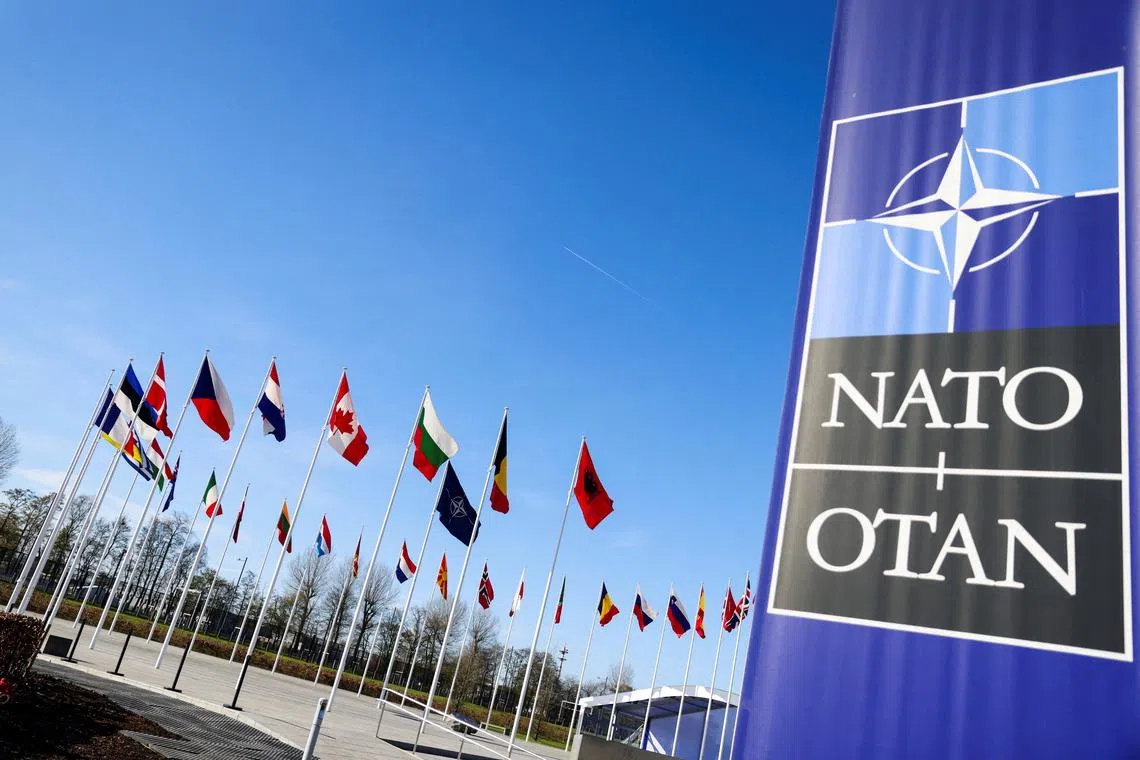Nato is spending more on defence, but it’s likely not enough
Sign up now: Get ST's newsletters delivered to your inbox

The increase in spending will be heavily showcased in Washington as Nato stages its show of unity.
PHOTO: REUTERS
Follow topic:
BRUSSELS - Spurred on by Russia’s war in Ukraine and the spectre of Donald Trump’s potential return to the White House, more of Nato’s European members are finally hitting the alliance’s defence spending target.
But as leaders gear up to celebrate at a Nato summit in Washington there is a clear feeling that will not be sufficient to tackle the challenges it faces.
“Even in countries historically reluctant to spend more on defence, there is now a growing sense of the importance of greatly increased defence spending,” said Mr Ian Lesser, from the German Marshall Fund of the United States, a think-tank.
“I think, broadly speaking, in the next years we’re looking at levels of defence spending that will begin to approach those of the Cold War.”
A decade after setting a spending goal at two per cent of gross domestic product, just over two-thirds of Nato’s 32 countries are now expected to reach or top that threshold in 2024.
That is up from only three allies in 2014.
The increase in spending, which includes European heavyweights Germany and France, will be heavily showcased in Washington as Nato stages its show of unity.
That is designed to send a message to Russia’s President Vladimir Putin as he wages his war in Ukraine
But it is also a message for former US leader Donald Trump as he seeks to reclaim the Oval Office
Like other US leaders, upset that Washington shoulders too much of the burden with its vast defence budget, Trump spent his time in office demanding European countries do more.
On the campaign trail in February he unleashed a firestorm by saying he would encourage Russia to “do whatever the hell” it wants to Nato allies not coughing up enough.
‘Hot war’
A year after turning the two per cent benchmark from a target to a floor for spending at a summit in Vilnius, a growing number of Nato allies are already pushing to go further.
Chief among them are the Baltic States and Poland – with all comfortably spending more, and Warsaw even reaching over four per cent.
“In 1988 all of the allies were spending more than two per cent, actually some even six per cent on defence because the threat was real – there was a Cold War going on,” Estonian Prime Minister Kaja Kallas said.
“Now we have a hot war in Europe and we are not spending enough,” said Ms Kallas, who was nominated in June as the European Union’s next foreign policy chief.
But the Washington summit still looks too early to set a more ambitious target.
“I think we’re keen to celebrate the progress,” a US defence official said. “There’s not an appetite this year to change that benchmark to three per cent.”
Defence plans
A major motivation for ramping up spending is making sure Nato countries can actually fulfil ambitious new defence plans agreed in 2023 to ward off any potential attack from Russia.
After years of slashing budgets as fears of conflict eased in the wake of the Cold War, numerous allies have major gaps in their arsenals – including key requirements such as air defences.
As part of its planning, Nato commanders are telling capitals what they need to spend on.
“We have specific capabilities targets for each and every ally,” said alliance chief Jens Stoltenberg.
“For many allies, this will mean three per cent, and at least something more than two per cent.”
Diverting money away from issues like welfare, education and health is never an easy sell for governments.
The likes of Canada, Italy and Spain still lag behind the Nato target and are reluctant to commit to going further.
But diplomats at Nato said the direction of travel is clear – spending targets will need to be hiked.
“Some countries are still sticking their heads in the sand,” said one diplomat. “But it will happen eventually.”
Another diplomat agreed – adding that if Trump starts breathing down the necks of European allies again that could speed things up.
“This is where we are heading towards – in order to fill the new plans it is clear that two per cent won’t be enough,” the diplomat said.
“I think we’re going to move to something beyond that, regardless of who wins the next US elections – but if Trump wins it could come sooner.” AFP

